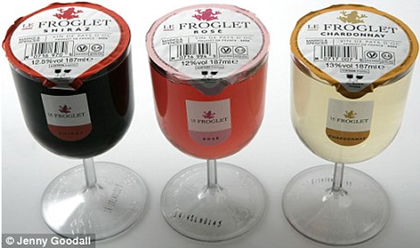Dr Vino's wine blog
wine talk that goes down easy
The $12 natural gamay showdown: Lapierre vs Puzelat
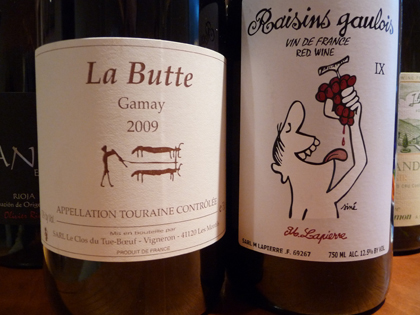
Marcel Lapierre, the vigneron of Beaujolais, is a grandpappy of minimal intervention, “natural” wine. And Thierry Puzelat in the Loire is a leading, young naturalista. In fact, Puzelat has credited the beauty of Lapierre’s wines as the inspiration for choosing the path to making such wines.
Each of them made a reasonably priced gamay in the acclaimed 2009 vintage; I bought each for about $12 at Astor Wines and then tasted them head to head. Turning to the master first, Read more…
Fill ‘er up: self-serve tanks bring wine to French supermarkets
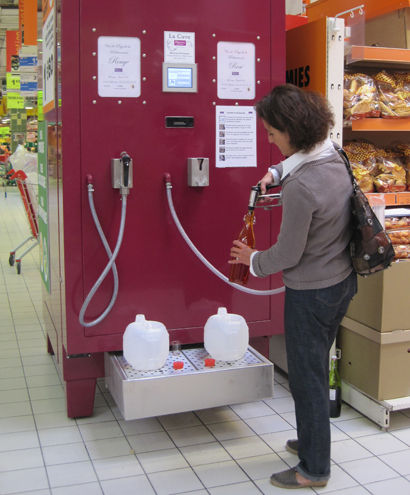
Keg wine and wine vending machines just got supersized: 500 and one-thousand liter tanks have landed in French supermarkets.
Bring your own resealable bottles, Poland Spring containers, jerrycans, whatever. Or you can get one at the store. Select your grade (red, white, or rosé). Pump. Print receipt.
Astrid Terzian introduced this concept that hearkens back to a bygone era when wine would arrive in Paris shops in tonneaux and consumers would bring their own flagons to fill. But today, Terzian says, she started this scheme in fall 2008 to fill a niche, tapping into two key themes, environmental awareness and the economy. (She actually wanted to buy a wine property and run a B&B but it was too expensive. So she turned to what she says she knew how to do: sales.) The elimination of packaging mass means that the wine can be shipped much more efficiently from a cost and carbon perspective.
The cost-savings are passed on to the consumer in the form of low prices of 1.45 euros/liter (about $2/liter). She installed her first machine in June 2009 at the Cora supermarket in Dunkirk and now has them installed in eight supermarkets in France. The wines vary; one is a 2009 from the Rhone, technically a vin de pays méditerranée.
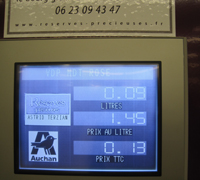 As to customer reaction, Terzian says customers are taken aback at first, but then warm up to the idea, especially after a taste. They come back often, she says.
As to customer reaction, Terzian says customers are taken aback at first, but then warm up to the idea, especially after a taste. They come back often, she says.
Asked via email which is her favorite container to bring to fill, she says she uses a five-liter jug since it is “neither too big nor too small–and it’s typically French.”
UPDATE: I neglected to mention in the post that I think this, regulations permitting, will come to the US within a year. I told that to someone in the wine trade today. And he replied that he is already working on it!
UPDATE 2: My only question about the pump wine (aka Chateau La Pompe) is if it comes to New Jersey and Oregon, will they require full serve as they do for gas?!
Adventures in packaging: single-serve wine in a plastic glass!
Forget screwcaps versus corks: An English entrepreneur has sold this invention of single-serve plastic wine glasses–stem and all!–to Marks & Spencer, which now “struggles to keep up with demand.” He is laughing all the way to the bank since a business reality show in the UK called “Dragons’ Den” panned the idea when he presented it on the show. Sold under the brand “Le Froglet,” the individual 187ml glasses cost £2.25 ($3.33) for a Shiraz, Rose and Chardonnay, which, apparently, come from the Languedoc.
What say you: abomination or genius? Would this solve all your needs for wine in the back of a taxi? On a train home from work? At picnics? Your wine-through-a-straw needs?
“Wine-in-a-glass entrepreneur ridiculed in Dragons’ Den toasts M&S success” [Daily Mail; also image] Thanks, Jessica!
Do you want alcohol levels in reviews? [poll] & a comment from Joly
Last week’s New York Times reviewed some wines from Savennières, the Loire appellation that makes often-stunning, always dry versions of chenin blanc. The article noted the alcohol levels from the label of each wine alongside the newspaper’s ratings, comments and prices.
Would you like to see more reviewers noting alcohol levels? Although what’s written on the label is what we have to go on as consumers, it’s not always accurate given that federal regulations allow one to one-and-a-half percent wiggle room from what’s stated on the label. Have your say in the latest poll!
Also, just how did the NYT panel’s favorite wine, Nicolas Joly’s Les Clos Sacrés from the damp 2007 vintage, reach 15 percent alcohol? This is the Loire, not Lodi, after all. For perspective, I asked Nicolas Joly for a comment, which follows after the poll.
[poll id=”15″]
Read more…
Wine tasting at Caves Auge – Tissot and Binner edition [Paris]
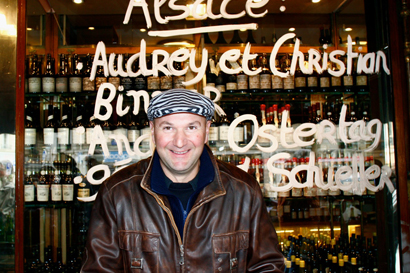
Stephane Tissot from the Jura outside Les Caves Augé in Paris.
Les Caves Augé, the excellent Paris wine shop, has fun, free wine tastings that spill on to the sidewalk. The shop is crammed with so many fine and fun wines that they mainly have to do these free tastings outside of the winter months, so the broad pavements of Boulevard Hausmann are at their most hospitable. For anyone traveling to Paris, there are three remaining Saturday tastings this season at Augé, “Wonder women” on June 5, “Loire” on June 19, and “bubbles” on July 10.
Although we’ve never met, Tim Eustis is a friend of a friend. He worked in wine retail in New York City and did wine consulting for seven years. About a year ago, he and his family moved to Paris. Back in March, he dropped by the first of the spring tastings. Over to Tim for photos and comments from his tasting some wines from the Jura and Alsace. I have liked some wines from Tissot (old vine Poulsard) and Binner (notably, the gewurztraminer) in the past so was pleased Tim had the chance to taste them.
By Timothy Eustis Read more…
Chateau Palmer revives an old tradition
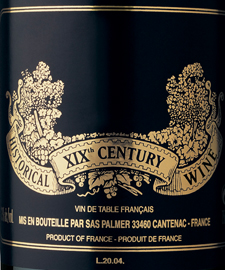 Vin de table lies at the bottom of the administrative heap in France: it’s derided, dirt cheap and sold in supermarkets by the flagon.
Vin de table lies at the bottom of the administrative heap in France: it’s derided, dirt cheap and sold in supermarkets by the flagon.
Paradoxically, however, producers who dare to do something different are all-too-often ending up in this undifferentiated tier. (I detail more of the shortcomings of the appellation process in my book, Wine Politics.) Although quality producers in Italy make wine outside of the DOC system, the French have clung with surprisingly fervor to the AOC system as relatively few have left, in large part fearing the stigma of vin de table.
Chateau Palmer, the “super second” classified growth from Margaux, does not appear to fit the profile of one to buck the system. But that’s what they’ve done with their “XIXth Century historical wine.” Apparently, blending syrah from the Northern Rhone with Bordeaux was fairly common in the pre-appellation controllée era, particularly in weaker vintages, to result in a wine that had been “Hermitagé,” so-called after the celebrated region that produces fine syrah.
To make the Historical wine, winemaker Thomas Duroux blends barrels that were otherwise destined for Chateau Palmer with no more than twenty percent syrah from “friendly” (but unspecified) sources in Hermitage, Cote Rotie, and Cornas. Although it has been produced only in 2004, 2006, and 2007, the label legally can’t state a vintage as a vin de table, so instead they rely on the microscopic font of the lot number, 20.06 in the one I tasted last week. The wine is nothing like shiraz, cabernet, merlot blends of Australia, but it’s not really very Margaux either since it is fuller and richer and showing more of the syrah character now. Of the 250 – 300 cases made, the chateau is holding back 50 cases for a minimum ten years to see if the wine changes back to show more of the Margaux character. Priced the same as Chateau Palmer ex-cellars, this isn’t your typical vin de table.
Syrah: beyond the fruit bomb
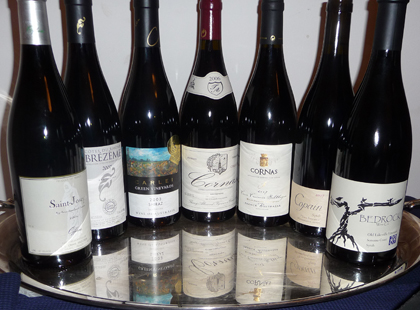
While Merlot’s fall from grace can be traced to one line in the movie Sideways, the fall of Syrah has been more difficult to track. Australian wine, with Shiraz as the signature grape, has experienced a decline in sales over the past couple of years. Even more broadly, it’s still a tough sell: producers and retailers have repeatedly told me that save for a few appellations in the Northern Rhone, the homeland of the grape, Syrah remains a sluggish category.
I was happy to have the chance to check in with Syrah by organizing a small tasting at a private residence last week. In putting together the seven wines in the lineup, I wanted to be sure to include examples from Australia, the US and the Northern Rhone but had the usual constraint that the wines actually had to be available locally. I decided to spare the tasters the hot-climate, jammy style and the boring cheapie style since they were probably most familiar with those, especially the latter, which is poured with abandon at fundraisers and art gallery openings. Read more…
Lafarge Bourgogne and Passetoutgrain 2007s
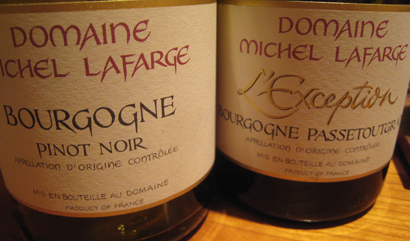
I recently bought the 2007 Lafarge Bourgogne rouge ($30; find this wine) and popped it open on a Friday evening for Mrs. Vino. With the delicious pinot noir in our glasses, light in color with excellent balance between acid and youthful tannin, the weekend was off to a great start. Then our neighbor dropped by to collect his son and, in no time flat, the bottle was empty. Our sipping wine got gulped! Good thing that fun wines are for sharing.
When I was speaking with Becky Wasserman recently, the Burgundy-based exporter of this and many other wines, she suggested to get to know a Burgundy producer by their Bourgogne rouge, a sort of house calling card for a relatively low entry point. In the case of Domaine Michel Lafarge, I’ve also had the chance to try the recent vintages of his Volnay; the 2006 has great snap and the 2007 has fine balance. So, good advice.
A previous evening Mrs. Vino and I enjoyed the Lafarge Bourgogne Passetoutgrain 2007, “L’Exception” ($24; find this wine). Passetoutgrain is the rare red Burgundy that allows grapes other than pinot noir in the wine since it is a blend that includes gamay. In this case, the grapes are interspersed in in the same vineyard (a field blend, as it is known) of fifty-five year old vines. They are harvested and fermented together. The resulting wine combines the gulpability of gamay with the structure of pinot. While I preferred the Bourgogne rouge, this is still a fun wine–as such, this switch-hitter is good for a relaxed evening of sipping but still a good choice in case any gulping neighbors drop by.
